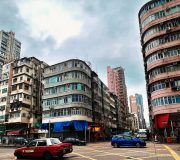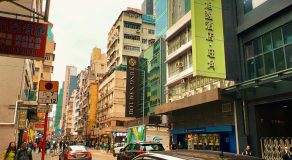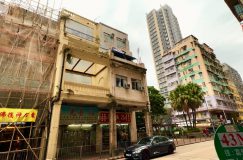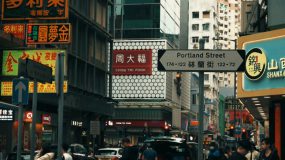LITTLE CHEUNG, DIR. FRUIT CHEN (1999)
Tong Lau, Yau Ma Tei District, Hong Kong
Youtube Link: https://youtu.be/_YDrGCNKj-s?si=l5d351GvP-MVaWcO
V: Hello and welcome to today’s Movie and Architecture Appreciation podcast. I am the host Vivien.
F: Hi everyone, I’m Floss, and the topic of today’s podcast is spaces, buildings or objects that will no longer exist in Hong Kong in ten years’ time.
- Background Sources
V: First of all, we will start with introducing the background source of this blog. Little Cheung is a Hong Kong movie released in 1999, directed by Fruit Chan. The movie unfolds from the point of view of a child named Little Cheung, describes a lower class tenant who operates a Tea Restaurant in the 1990s. In this film, Yau Ma Tei is a cultural and architectural symbol of the older urban areas. Among these nostalgic spaces, Tong Lau, which carries the living atmosphere and the emotional cohesion of the lower class of society, is one of the most representative landmarks. Why do you think Tong Lau will gradually disappear in the near future?
- Architectural features of Tong Lau and reasons for disappearance
F: Before the detailed description, I would like to introduce the architectural characteristics of Tong Lau. Tong Lau appeared in the early 20th century and became the main housing type for Hong Kong citizens at that time. This photo was taken in 99 Portland Street, Yau Tsim Mong District, which shows Tong Lau is generally three to eight floors with multiple tenants and adopt a mixed pattern with stores on the ground floor and residential space on the upper floors. However, the wooden floors often suffered from cracks and were difficult to clean. Also, due to the influence of colonial architectural design and investment policies at the time, Tong Lau represented the living environment of the underclasswhich constructed with bricks that porous and of poor quality, walls were easily deteriorated and collapsed (Chu, 2012).

V: The unique features of Tong Lau are also reflected in the rounded facades. This picture shows a cluster of Tong Lau in the vicinity of 8 Waterloo Road in Yau Tsim Mong District, where the proximity between each building and windows reflects the high density of households. The two outlying Tong Lau between the traffic corridors have their side elevations curved in order to reserve enough space for the narrow corners of the road junction. However, it is difficult to see such a design in modern buildings due to the constraints of cost and use of internal space.

F: Yes, I agree. In addition, the trend of globalization influenced the reshaping of modern cultural symbols. In the photo taken near 68 Portland Street in Yau Ma Tei, the funeral house on the left was featured in the movie Little Cheung, it still retains original traces decades later. The scene through the vertical extension footage shows this age-old building is separated from the modern landmarks such as skyscrapers and hotels. As urban construction focuses on evacuation and subdivision, buildings which are inconsistent with the standards of modernization of density and supporting facilities, will gradually disappear.

- Tong Lau: Mapping the Past and Modernity
V: Absolutely. We will now introduce the changing significance of the building’s existence. During the twentieth century when Tong Lau were flourishing, the high density of tenants and the low cost of renting provided shelter for the massive influx of exiles and the local underclass. It served as a vehicle for the integration of multiple functions, creating semi-open corridors and complementary spatial patterns of movement and static (欧阳一菲,2019). In the photo of the old Tong Lau at 316 Shanghai Street in Yau Tsim Mong District, the stone pillars underneath the building support a separate corridor space. This design providing diversified possibilities for the transfer of information and culture between neighbors at that time, and realizing the transformation of a closed area into an open public space.

F: Yes, in today’s modernized world Tong Lau have other social mappings. As the urban space is facing the status quo of restructuring, reorganization and updating, Tong Lau have become cultural symbols carrying the emotions and thoughts of the people in the old times, and have witnessed the changes in Hong Kong’s international status. So, what groups of people will be affected by the disappearance and what emotional transformation will it bring?
- The social impact and emotional shift brought about by the disappearance of Tong Lau
V: Tong Lau as the spatial framework of colonial policy and daily social life, is not only a representation of the dominant ideology, but also a medium for the underclass groups to reconstruct their cultural values and emotion (Scriver & Prakash, 2007, as cited in Chu, 2012). The disappearance breaks the connection between civic identity, cultural imagination and the building, makes people rooted in local culture lose their sense of belonging.
F: That’s true. In addition, different groups will have different attitudes and feelings towards the disappearance of Tong Lau. Scholars who study architecture and advocate historical preservation will disapprove the vanishing of old era symbols, while ordinary people who have emotional links and identification with the building or vendors who rely on Tang Lau to operate shops will feel upset and unacceptable.
- Vanishing status quo and countermeasures
V: Since 2015, Hong Kong has gradually begun to demolish Tong Lau, such as Tung Tak Pawn shop in Hennessy Road, Wan Chai. However, in recent years, people have listed historic buildings with special inscriptions as cultural heritage, paid attention to and implemented protection policies to strike a balance between conservation and development of Tong Lau (Penića et al., 2015).
F: To sum up, the demolition of these buildings that carried spiritual power and sense of belonging, the original cultural characteristics of the city were homogenized. The scene shows in photo near 122 Portland Street proves that the emergence of modern malls and shops has diluted the local character of the city. Therefore, dealing with this issue is necessarilly to take a long-term view and form a social consensus.

V: I totally agree. Let us pay attention to the preservation and inheritance of the buildings around us, protect the cultural symbols and leave precious historical heritage for future generations.
F: That’s all for today’s podcast. Thanks for listening. See you next time!
V: Goodbye. See you next time!
SONG Yiqun 3036097293
ZHANG Xinyi 3036094813
Reference:
Chu, C. L. “Between typologies and representation: the tong lau and the discourse of the” Chinese house” in colonial Hong Kong.” Colonial frames, nationalist histories: imperial legacies, architecture, and modernity (2012).
Penića, Milja, Golovina Svetlana, and Vera Murgul. “Revitalization of historic buildings as an approach to preserve cultural and historical heritage.” Procedia engineering 117 (2015): 883-890.
欧阳一菲. ““港味” 的追溯, 突围与重构——以香港电影中的 “唐楼” 建筑为例.” 南京师范大学文学院学报 3 (2019).